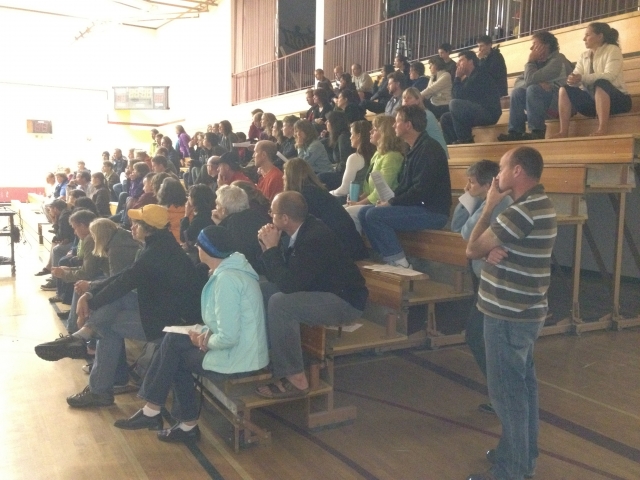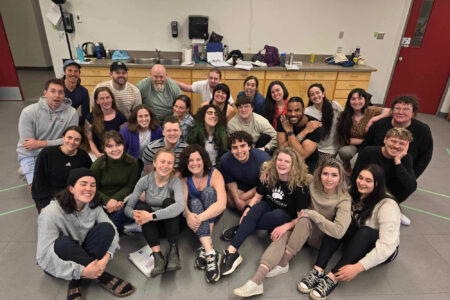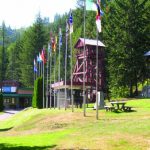Rossland Secondary pioneers innovative learning approaches
Parents, students, and teachers gathered at the RSS gymnasium on Tuesday evening to learn more about the new system of “inquiry-based learning in a blended environment” that RSS plans to implement across its Grade 10 to 12 programs in the 2012-2013 school year.
The new model is characterized by flexible timetables, a variety of individual, small, and large group sessions, teacher-student collaboration on planning and facilitating projects while still covering essential course material, online material to increase teacher-student contact in the classroom, as well as seminars and guest speakers.
Lavender told the audience—which included some trustees of the School District 20 (SD20) board, and the SD20 superintendent Greg Luterbach—that after decades of rhetoric, these changes will “really make RSS a school of 21st century learners.”
In fact, as Luterbach confirmed in a comment after the presentation, RSS is unique in SD20 for its wholehearted pursuit of these new approaches. He said, “There are [similar] pieces in different schools, but putting all those pieces together in one environment? No one yet.”
Lavender said, “Other schools in SD20 are already using elements similar to what we have, but not to the same extent in terms of blowing up their timetable and individualized scheduling.”
She added, “The academy was doing a lot of these things, but never with the benefit of extra teachers and small groups of students working together.” She described a spectrum from traditional learning to online distance learning, and said the academy was “just off to the side of distance learning.” Blended learning aims for “the sweet spot in the middle.”
Lavender described “push factors” that are moving RSS in this direction, such as declining enrolment, but she also said “huge pull factors” include the desires of parents, students, and the teachers themselves for a new way of learning.
“There’s a pull from the teachers,” she said. “They want to do something different. it’s time. Teachers have been meeting every Tuesday for the last five months leading towards what they see is a forward-thinking, modern classroom.”
SD20 board trustee Gordon Smith commented later, “The students are pulling as well, they’re looking for the opportunity to select project-based learning.”
Lavender said the new system will meet the desires of students who “want to set their own pace,” she said, and “want the teacher to know about them, and care about them.” RSS surveys also show that students want their studies to be more relevant to the world beyond the classroom walls, and they want “flexibility on where, when, and what they learn.” She said, “We want every learner to be challenged, successful, and want to come back to school the next day.”
Lavender hopes the changes will also help fulfill parents’ desires for their children to “think, understand, communicate, and problem solve—not just memorize content.” She said it will help students set goals and be self-motivated to “have a good work ethic.”
The changes will be most apparent in Grades 10 to 12. There will be a gradual transition from a “very teacher-centred” structure in Grades 6 and 7, much like it is now, to “more independent learning in Grades 8 and 9.”
Even in Grades 8 and 9, however, “you will still see a similar structure to what you’re used to seeing,” Lavender said, “with courses, periods, and blocks,” but there will be a move towards “blended learning.”
And it’s blended learning, with it’s flexibility and wide choice in course selection and delivery, that will make the Grade 10 to 12 program “look really different,” Lavender said. She called up Vice Principal Mike Vanness, teacher-librarian Nicola Kuhn, and academy, science, and Grade 6 and 7 teacher Bernie Hoffman to get into the “nuts and bolts.”
Vanness described new “advisory groups” that will take place for 15 minutes every morning, in which students will meet with the same teacher each day, sometimes individually, or in small groups, large groups, or even a whole grade at once. Vanness said students will collaborate with teachers to set goals, both long and short term, and “set up how those goals are going to be met.”
“It increases communication,” Vanness said. “It gives us one teacher who can answer quite accurately about how a student is doing. If a student is having trouble with a course or an assignment, they can talk to the advisory teacher.”
Another innovation will be “resource areas.” There will be one for humanities and one for math and science, Vanness said, about the size of two classrooms and occupied by an “expert” in those fields “at all times.”
“It might not be their actual teacher, but it’s an expert in that area who can help them,” Vanness said. “It will be open all day, every day. We’re trying to get away from spares and hanging around the foyer, and it helps with student’s problems. What we’ve found is that as students get to higher grades, teachers are not as available for them.”
Vanness described the “course elements” that structure the new approach. Unlike standard classrooms of regular sizes, the new approach allows teachers to use different “elements” depending on the need. Large groups of students, 30 or more, could be brought together for a lecture, seminar, or guest speaker. Teachers might also schedule small groups of five to 15 students, or even collaborate on elements with other teachers.
At the heart of the learning model is “project and problem-based learning” that leaves students “free to line up outcomes with course content.” Vanness said students can “direct their learning to areas they really are interested in, and still fall within the course outcomes. Student interest tends to go up, and students tend to dive deeper into what they’re trying to learn.”
This educational model also uses “flexible timetabling” that gives teachers much broader scope in how they can use student’s time. Vanness said the increased efficiency in staffing due to flexible scheduling has allowed RSS to increase the number of courses they offer upper level students. “If it works, we’ll add more things next year,” Vanness said. “All the specialty teachers are still here, and they’re all very good.”
“We gave kids a huge list of courses to choose from,” Kuhn said, “courses we’ve never offered before. They can choose their learning path and work with an advisor to decide when for them is the best time to start a course.”
Kuhn defined blended learning as the “best of both worlds,” mixing face-to-face contact with teachers, students, and the local community with online contact between the same people as well as other communities and resources.
“Ultimately, what you get is more teacher contact time,” Kuhn explained. The new model frees teachers from the front of the class, giving them more time “to sit one-on-one with individual students or in small groups.”
Kuhn gave the example of an English class last year that combined English 10, 11, and 12. She called it “a collaborative event” and noted that “two or three minds working on a course come up with great ideas,” while students get a choice of teachers with whom to work.
She went into some detail about the importance of “self-paced learning,” and how the blended learning approach allows teachers and courses to “cater to students’ needs,” and also gives the teacher more opportunity to “learn who they are, what their passions are, and to provide them a choice.” She said, “All students learn at a different rate. They have different strengths, and different ways to learn.”
Kuhn questioned the concept of “a pass.” She said, “50 per cent means they don’t know everything—we’re setting them up for failure.” Instead, with self-paced learning, “we’re looking for mastery,” she said.
She addressed the inevitable question before it came up: “what if my kid’s lazy and doesn’t do anything?”
Kuhn said, “There are more catches in place than ever before—there’s the teacher advisor, the classroom teacher, and you [the parent].” She explained that parents also have a responsibility to observe how their child navigates their educational path.
As one way to learn, Kuhn said, “our students are keen to get out in the community.” She also spoke to the importance of “online contact” and introduced “Moodle,” an open-source, community-based, online learning tool.
“There’s this rumour that everything’s going online. That’s not the case whatsoever,” Kuhn said, reiterating the importance of face-to-face contact and the many ways these forms of contact are integrated into blended learning.
“Moodle is like a jar, a receptacle, and you can put anything in it,” she said.
Moodle makes a single, accessible location to house the wide variety of course content, she explained, and helps give students the flexibility to construct their particular learning path as each course “branches” out to meet the needs of different students. As importantly, Kuhn said, it gives parents access. “They can go in and see the course content and see the choices each student made,” Kuhn said.
Kuhn also addressed how online approaches “enrich discussion.” She said “online discussions at the higher level are much richer.” Kids that talk a lot no longer dominate the conversation, quieter kids join in, and “some students leave school, reflect, and choose to comment later.”
Another advantage of a strong online component is the “flipped classroom” that Kuhn said is “becoming a big deal” in pedagogical circles. Instead of the teacher delivering content in class, they create a tutorial video that students can access at home and watch as many times as they need to. That way, “when they get to class, they can really talk about what they’ve learned previously,” Kuhn said, noting that how this plays out “will look different in each teacher’s class.”
The online components also allow kids to “forge ahead,” if they want to, or if their family chooses to go on a trip for two months, Kuhn said.
Hoffman addressed the bigger, provincial picture, and how the changes at RSS fit into the Ministry of Education’s plans. “We know that students learn more when they’re interested in what they’re studying, but we haven’t always had the structure set up to support that,” he said. Hoffman went on to describe how changes at the provincial level have opened new possibilities.
“There are really exciting things coming from the ministry in terms of giving us license to do things differently,” he said, with particular reference to “personalized learning” in the BC Education Plan. As one example, he was pleased by the reduction of learning outcomes. “We can get into the learning at a much deeper level [with fewer ‘outcomes’]” he said, “rather than skimming the surface on a lot of content.”
Hoffman widened the scope and said, “Just about every province in Canada is looking at some of the elements we’re introducing this year.” Looking further afield, he drew on Finland as a model for blended learning.
He stressed that the updated approaches incorporate the best of face-to-face teaching, online tools, and self-paced, student-directed learning that aims at “mastery,” not memorization, and promises a “deeper” and “more meaningful” level of education.
The RSS teaching staff have been moving in this direction with “enthusiasm” and a “great deal of thought,” he said. He even noted one RSS teacher who had plans to retire this year but may yet change her mind, excited by the prospect of “doing things differently.”
Inevitably, someone mentioned the elephant in the room: provincial exams.
“As much as I’d like to say they’re gone, we still have provincial exams,” Lavender said. “We still have outcomes to meet, and we’re still responsible and accountable to that—how we’re teaching it is just going to look different.”
“In terms of what a kid would say they’re getting out of [school],” she continued, “they’ll get a whole lot more out of it. It’s more than a math test with a mark.”
A recent RSS experiment in this style of learning ended with projects as varied as an invasive species assessment, local watershed testing, and an analysis of the impact of water scarcity on conflicts around the world. “The feedback was amazing,” Kuhn said.
One student asked Kuhn at the beginning of the course, “How do I get an ‘A’?” She answered: “You demonstrate that you’ve learned something.”
“By the end of the course, he didn’t care about his grade,” Kuhn said, “He’d tested all the water between here and Warfield. He figured the knowledge he gained about what was in his own water meant so much more than his letter grade. Multiple choice doesn’t test that form of learning.”
Lavender expressed the potential she sees: “Students will learn the skills to create long and short term goals, organize their schedules to meet their learning needs, reach out beyond the school walls into the community, collaborate with peers, teachers, parents and community members, take on leadership roles, and share their learning with others—locally and globally.”
“We are truly excited about the changes we are making,” she said, “and remain dedicated to meeting the needs of every single student in our school.”
























